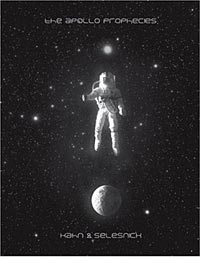Review: The Apollo Propheciesby Eve Lichtgarn
|
| Children will love the whimsy of these images and anyone with an appreciation of space as a frontier will admire the extravagance of the publication’s production. |
The photographic panorama is segmented into 60 panels and it can be paged through like a book or unfolded accordion style for a flowing mural effect. Free of text, we see a rocket launch a stylized space capsule to the moon. The pair of Apollo-era astronauts aboard land on the lunar surface, unpack the lunar rover, and embark upon the tasks of observation and rock collecting. They soon encounter a friendly civilization of Edwardian-era explorers, in addition to helpful space-suited monkeys and elephants, living on the moon. The truly ancient astronauts help the Apollo spacemen prepare their craft for the return voyage to Earth. Children will love the whimsy of these images and anyone with an appreciation of space as a frontier will admire the extravagance of the publication’s production.
The separate text is a hilarious spoof of overwrought Norse sagas and rambling biblical tales. All the touchstones are acknowledged, from Sputnik and Gagarin to Kennedy and Aldrin. A wonderful example is this “ancient hymn of weeping and resurrection:” “Oh Laika! Sad and noble Laika. Laika of milk and Laika of wool. What a fine Laika! Such a Laika as has not been seen; or rarely, rarely, indeed. Dear, old, dying Laika, do not leave us sad and Laikaless!”
Nicholas Kahn and Richard Selesnick are the two visionaries behind this conceptual tribute to the manned space program. They have collaborated on prior art books and their photography has been exhibited internationally. Harvard research scientist Erez Lieberman collaborated on the text of The Apollo Prophecies, giving it the ring of reality.
Perpetuating the myth is an editors’ note that reads, “It is a little-known fact that when the Apollo astronauts returned from the moon, they brought back evidence of a previously unknown lunar expedition. This evidence comprised several cardboard canisters containing lunar breccia and, more significantly, a document written by the early explorers that prophesied the future arrival of the NASA astronauts themselves. Most saw the document as a forgery, not least because the early explorers viewed the coming astronauts as cosmic deities. Whether the prophecy is authentic or not, its vision is hard to deny--if any man is to be transformed into a god, what better candidate is there than one who has ascended into the celestial sphere and stood alone on a distant world?” What better candidate, indeed.
The Aperture Foundation is located at 547 West 27th Street, 4th Floor, New York, NY 10001 and can be contacted at (212) 505-5555 or aperture.org.
